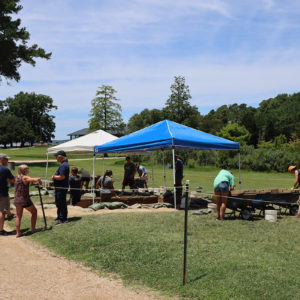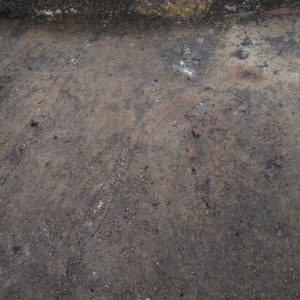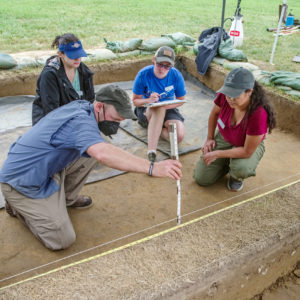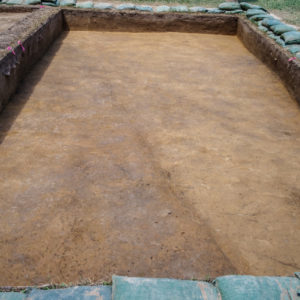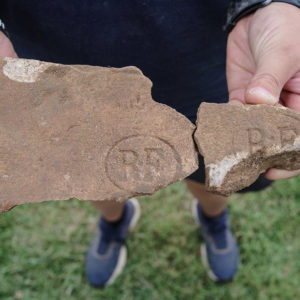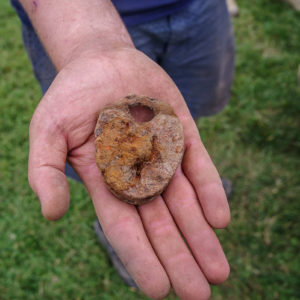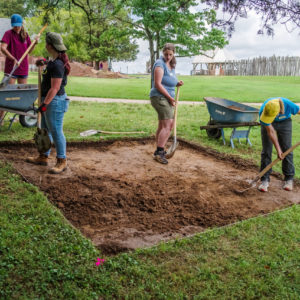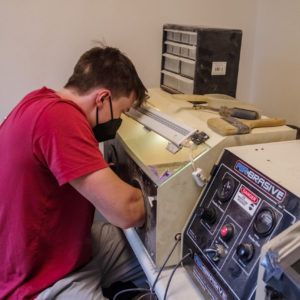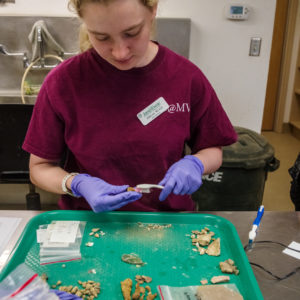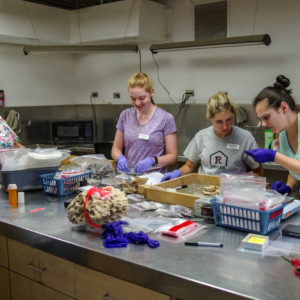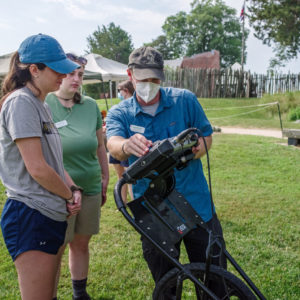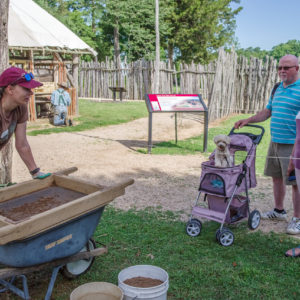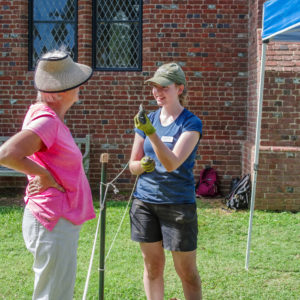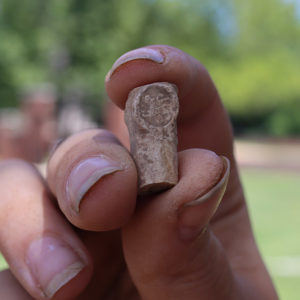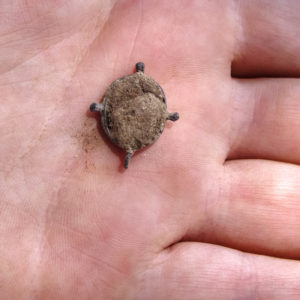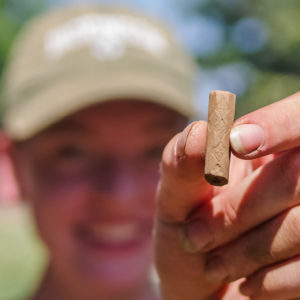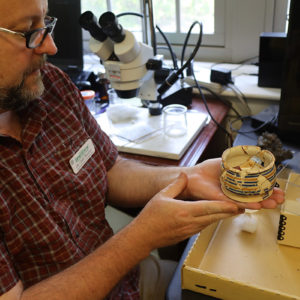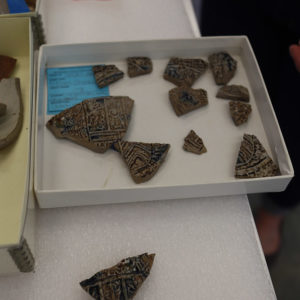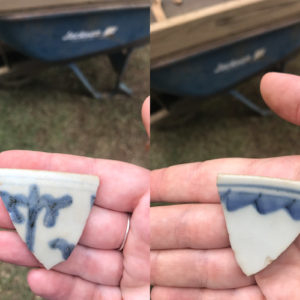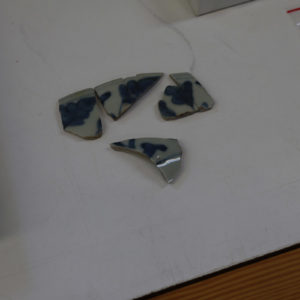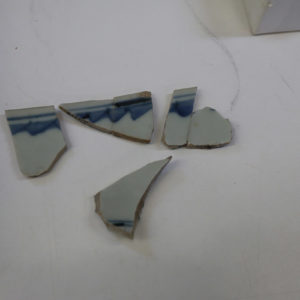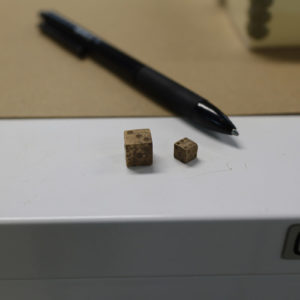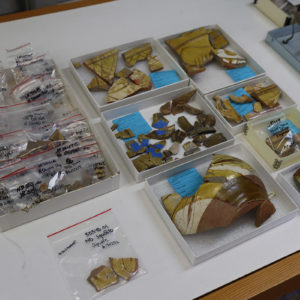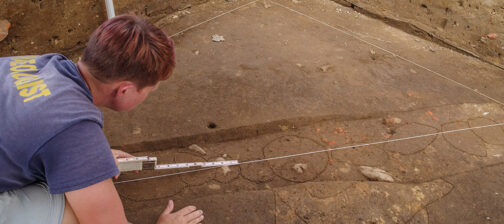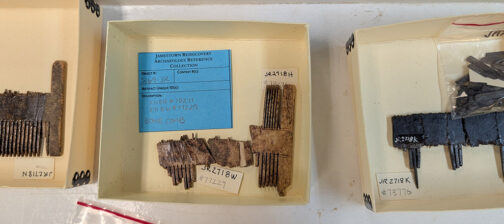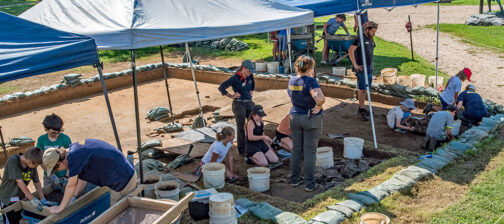Excavations are underway at three different sites in and around James Fort. Thanks to the extra hands of the 2022 Field School students, the Jamestown Rediscovery team is able to simultaneously dig in the field north of the north bulwark, uncover a grave a few yards to the east, and also continue the work north of the Church Tower. Several exciting features are being investigated and the north Church Tower dig has yielded many early artifacts including sherds of Bartmann jugs and two bone dice, the latest of over 80 dice found at Jamestown.
In the excavations just north of James Fort a rather wide ditch has been found that runs roughly north/south. The ditch doesn’t end within the bounds of the 10’x 10′ squares that the archaeologists and Field School students have opened so far. The eastern edge of the ditch has been found but not the western, making the ditch a very substantial one of at least 6 feet in width. These excavations confirm the results of the GPR survey conducted in this area last month. According to that survey many more squares will need to be opened before the ditch’s termini are reached. A large amount of charcoal is interspersed with the soil here and the archaeologists are digging down an inch or two more to find the bounds of this ashen feature. A small posthole was also found in these excavations. It is difficult to tell its significance without the presence of other postholes but perhaps further excavations will reveal more. This area has been rather devoid of artifacts lately; typically a sherd or two of pottery and small iron objects are being found by the Field School students screening the soil.
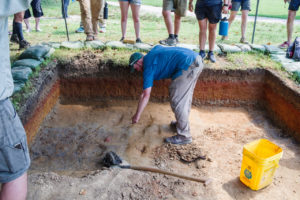
Another area near a branch of the Pitch and Tar Swamp is being excavated due to the presence of a grave there. J.C. Harrington, an archaeologist with the National Park Service, found the burial during excavations in 1941. The Jamestown Rediscovery team is interested in learning how the increasing inundation events due to rain and the rising water levels of the swamp have impacted the human remains inside. Their findings may instruct them on which burials to investigate next and how to approach these excavations. The team has dug down to the level of the grave shaft and has also found a posthole nearby, but artifacts have been few and far between.
A third dig site, just north of the Church Tower, continues to be excavated. Another early posthole has been found here — dating to the early fort period — which may be part of a mud and stud building or part of the fort itself. The archaeologists are also seeing a continuation of the planting furrows found in other adjacent squares previously. Along with these early features 20th-century utility lines criss-cross the excavations here. While the other two sites have yielded sparse numbers of artifacts, the north Church Tower excavations have provided quite a bit more. Faunal remains, namely pig and cow bones, sturgeon scutes and gar scales have been found here. Glass panes, large numbers of bricks, Chinese porcelain, North Devon sgraffito slipware, and Bartmann jug sherds, and two bone dice.
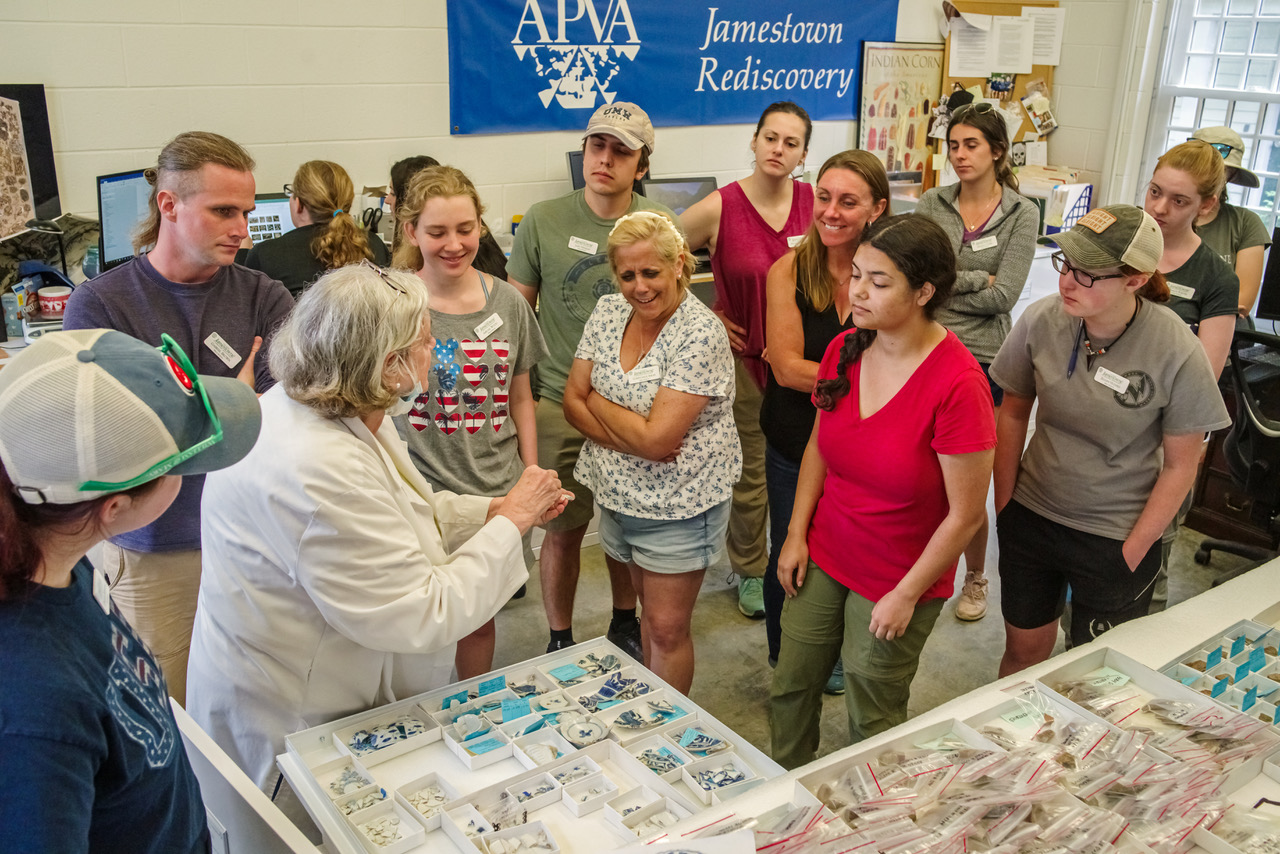
Inside the Jamestown Rediscovery Center, groups of Field School students have been learning about processing and conserving artifacts once they come in from the field. Guided hands-on lessons from our staff include documentation, sorting, washing, photography before and after conservation, air abrasion, and monitoring of environmental data for artifacts that are sensitive to humidity and temperature changes. The students are cycled between this work and the excavations outside to gain experience on all aspects of the archaeological process.
related images
- The excavations north of the north bulwark
- Plow scars found in the excavations north of the north bulwark. They have been scored with a trowel to make them easier to see.
- Senior Staff Archaeologist Sean Romo teaches archaeological techniques to members of the Field School.
- The large ditch (darker soil) found in the excavations north of the north bulwark
- Two brick fragments with the letters “RF” on them (probably a maker’s mark) found in the excavations north of the north bulwark. These likely date to the late 19th-century. Two similar fragments already exist in the Jamestown Rediscovery collection.
- An iron padlock found in the excavations north of the north bulwark
- The beginning of the excavations at the burial site
- Field School student Maxwell Gundling practicing air abrasion in the lab.
- Field School student Abigail Wood cleaning artifacts.
- Field School students in the lab cleaning and sorting artifacts. Assistant Curator Janene Johnston and Collections Assistant Lauren Stephens give guidance.
- Senior Staff Archaeologist Sean Romo teaches Field School students how to operate the GPR.
- Field School student Kira Alfano discusses the north Church Tower dig with visitors.
- Field School student Mandy Porter shares a sherd of Chinese porcelain with a visitor. The sherd was found in the north Church Tower excavations.
- A clay pipe found at the north Church Tower dig. A lion is imprinted in the pipe’s heel.
- A religious medallion found in the north Church Tower dig
- Field School student Mandy Porter holds a piece of a Robert Cotton pipe found in the north Church Tower dig.
- Archaeological Conservator Dr. Chris Wilkins works on a drug jar from the Archaearium that needed repair.
- A sherd of a Bartmann jug (bottom) found in the north Church Tower dig that belongs to a partial vessel already in the collection. The medallion on the jug is the Coat of Arms of Duchy of Julich Cleve Berg Mark Ravensburg. This is a common medallion in the Jamestown Rediscovery Collection.
- A sherd of Chinese porcelain found in the north Church Tower excavations…
- …that may be a part of an existing partial vessel in the collection.
- Interior of Chinese porcelain sherds
- Two bone dice found in the north Church Tower excavations. These have concave numbers. Over 80 dice have been found in and around James Fort.
- Sherds of North Devon sgrafitto slipware found in the north Church Tower dig (at lower left) along with other examples in the collection.



